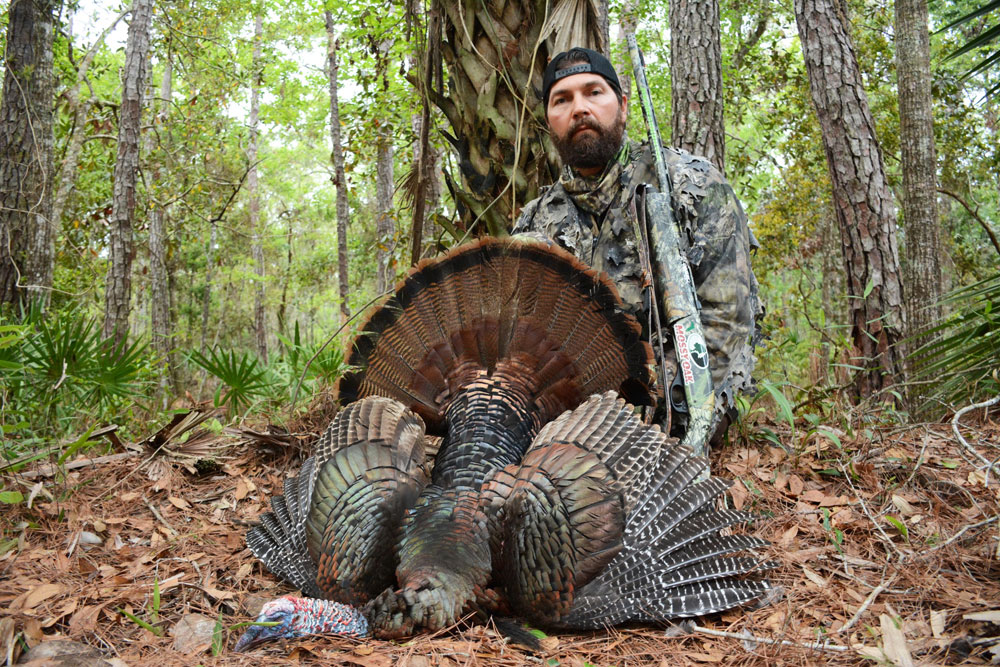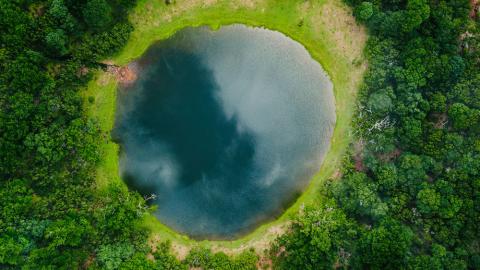provided by John Phillips
Mossy Oak Pro Ron Bachmann of Spring Hill, Florida, is living his dream of hunting and fishing fulltime since his retirement three years ago, after 20 years as a cable-company lineman. He’s been hunting turkeys for 21 years and has been on the Mossy Oak ProStaff for nine years. Florida’s spring turkey season opens at various times, according to where you plan to hunt – private and/or public lands, but Florida always offers the first spring turkey-hunting opportunities in the country. Florida is also the only place in the world where the Osceola subspecies of wild turkey is found, with 80,000-100,000 Osceola birds primarily concentrated in the center 2/3 of the state. Today a guide with Florida Outdoor Experience, Bachmann has hunted Rio Grandes, Merriam’s and Eastern wild turkeys too.

When I finish guiding hunters to turkeys in Florida, I have a lease in Alabama that I enjoy going to and hunting Eastern gobblers. Most people like to hunt the first week of turkey season, but once I’m finished guiding for Osceolas and come to Alabama, most of the breeding is over, and hens are few and far between. But I haven’t had any problems taking Eastern turkeys in Alabama for the last four seasons. So, I am of the opinion and have learned from my experience that the end of the season seems to produce more harvestable gobblers for me than the first of the season. I guess too, I’m fortunate in that the other six guys on the lease with me aren’t turkey hunters. They’re deer hunters, so I think that the property doesn’t receive any turkey hunting pressure, until I show up. The hens have all pretty much gone to the nest, and I’m probably only one of the only girls talking to those late-season Alabama gobblers.
I really don’t change my calling much at all when I call Easterns. I still call softly; I don’t overcall the birds, and I depend on my patience for success more than I do my calling. A thing that I don’t do is depend on my diaphragm call as much when I'm calling Easterns as I do a pot style call. I like a slate call more than a glass call. I usually start off with a pot call. Once I get a bird to respond, then I will soften my calling by going to a diaphragm call to finish him off.
I've found that most of the turkey hunters I guide like to overcall. I don’t know whether they just like to hear themselves call, or they think that the more they call, the better the odds will be to get a turkey to gobble. I've found out that less calling and more patience produces turkeys quicker than a lot of calling does. Yet another problem that many hunters have is they don’t know how to sit still and will be scratching, turning their heads back and forth, rearranging their legs, looking back and forth - all movements turkeys can spot to identify hunters.
Another mistake that I guess hunters just don’t think about when they sit down is having the sun in their faces. When a hunter is lit-up like a Christmas tree by the sun, he is much easier for a turkey to pick out than when he’s sitting in the shadow of a tree, a bush or a dead fall. Too, some hunters sit in the open rather than sit up against a tree bigger than their shoulders. They really believe that when they put on their camouflage from head to toe, they are invisible. However, they don’t realize that Mossy Oak camouflage makes them blend in with their environment and that is when they become invisible.
I think the two most difficult aspects for most hunters is sitting still and being quiet. I guess those two things are what most people practice the least in their jobs. So, when they come out into the woods, sitting still and being quiet are conditions they’re not accustomed to, and perhaps they feel uncomfortable trying to get into that mode of consciousness. I've learned that the best thing I can do before we hunt turkeys is to go with my client to sight in his gun, eat dinner with him and just sort of hang out with him for a while. If he is fidgety or seems to move a lot or likes to talk a lot, or has to get up and walk around when we go into the woods and hear a turkey gobble, I may sit him where I want him to sit. Then I’ll cut down some branches and limbs to put down around and in front of him to make a blind for him. If he is still moving and looking around too much on the next hunt, I will take a pop-up blind with us, and the two of us will get into that pop-up blind. That blind usually solves the problem because if he’s wearing full Mossy Oak camouflage and in the full shade of that blind, there’s much less chance of a turkey spotting him.






























